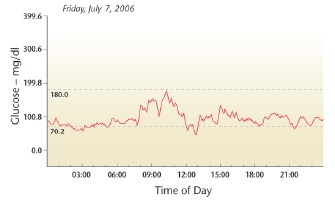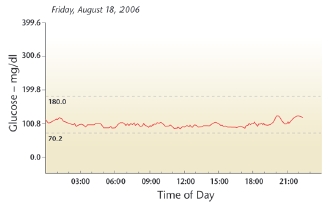Blood sugar and appetite are monitored by various systems within the body. For example, specialized immune cells that surround every brain cell can sense the level of glucose in your blood. Every time blood sugar drops rapidly, these cells send signals to parts of the brain that cause you to feel hungry. If you are overweight, insulin resistance and cravings can make your brain send out hunger signals even when it is inappropriate.
When your blood sugar levels routinely rise dramatically and then drop quickly (due to insulin secretion) you can develop insulin resistance. Your body doesn’t respond as it should to insulin, so more is needed and a vicious cycle develops. “Blood sugar roller coaster” is a good way to describe the phenomenon of blood glucose levels that rocket up and down. But, this is one roller coaster you don’t want to ride. These highs and lows are very hard on the body and can contribute to uncontrollable food cravings, weight gain and more serious health conditions.
A safe and effective route to weight loss is to greatly increase your consumption of dietary fiber. Unfortunately, you would need very large amounts of ordinary fiber to achieve significant weight control—higher quantities than most people would be willing or able to eat. Doctors recommend you consume 30 grams of fiber per day, however most Americans eat a maximum of 15 grams of fiber daily. In reality, 75–100 grams per day of conventional dietary fiber would probably be required to produce a feeling of satiety in overweight individuals. But, no one could eat that much regular fiber!
While bran and other non-soluble fibers support digestive health, it is soluble fiber that reduces appetite, balances blood sugar and lowers cholesterol. Soluble fibers are indigestible plant compounds that can absorb water. Their effectiveness at increasing satiety and improving blood sugar balance is directly proportionate to the amount of water the fiber can absorb and retain. The thickness or viscosity the fiber develops as it moves through the stomach and intestine is also a key to its effectiveness. For example, oat bran lowers cholesterol and controls blood sugar better than wheat bran because it absorbs more water.
The most thoroughly researched and best example of a superior soluble fiber is known as PolyGlycopleX®, or PGX®—an entirely new complex produced with three natural fibers. Sophisticated analysis has shown that PGX is a novel, revolutionary type of fiber. When taken before or with meals, the PGX complex increases both the volume and viscosity of food because it binds water more effectively than any other known fiber. It was developed after many years of research, most of it focused on the link between blood sugar levels, appetite and weight gain. PGX safely and effectively supports healthy blood sugar levels within normal range, reduces appetite and helps with healthy weight and maintenance. The fibers in PGX multiply each other’s effects, exerting health benefits that would be expected from much larger quantities of single fibers or other fiber blends. (View studies at www.pgx.com)
PGX is an excellent example of how soluble fiber can enhance health. It has extremely high gel-forming properties and absorbs hundreds of times its weight in water, creating volume and viscosity three to five times greater than single fibers like psyllium or oat bran. This is revolutionary in the science of satiety. Now, small amounts of PGX can be consumed before meals to produce results equivalent to those previously only possible by eating enormous quantities of any other fiber.
Research has shown that incorporating PGX into a healthy diet can: (View studies at www.pgx.com)
• reduce appetite and promote effective weight loss
• increase the body’s levels of compounds that block appetite and promote satiety
• decrease the levels of compounds that stimulate overeating
• reduce the glycemic index of any food or beverage
• promote healthy blood sugar control, as well as healthy blood cholesterol and triglycerides (already within normal range)
• help to develop a life-long healthy relationship with food
It’s important to note that PGX is not intended to treat, cure or prevent any disease. It is a dietary supplement designed to support healthy weight loss.

Figure 1: Uncontrolled and erratic blood sugar levels of an overweight woman over 24 hours with a poor diet and no physical activity.

Figure 2: Controlled and balanced blood sugar levels of the same woman after consuming PGX for six weeks and experiencing a healthy weight loss of two pounds per week.
How to Use PGX
To promote successful weight loss and maintenance, ingestion of 2.5–5 grams of PGX at major meals and perhaps an additional two times or more between meals for those with an appetite more difficult to tame is recommended. PGX is available in capsules (either hard or soft gelatin), as granules to be added to food and beverages and in a highly nutritious meal replacement drink mix.
Published in WholeFoods Magazine, March 2012










